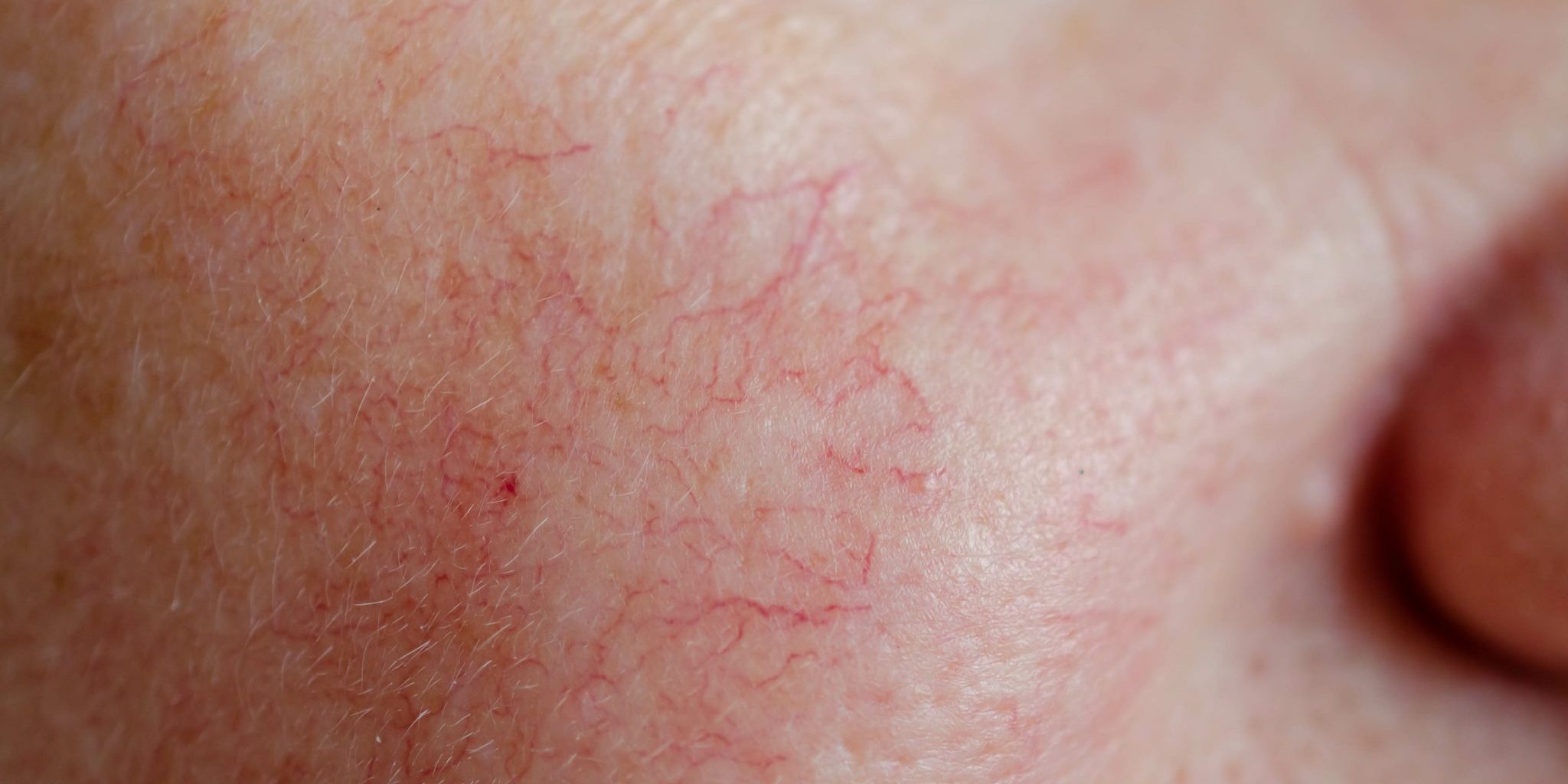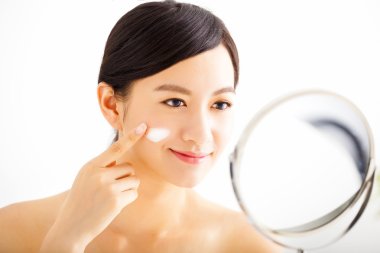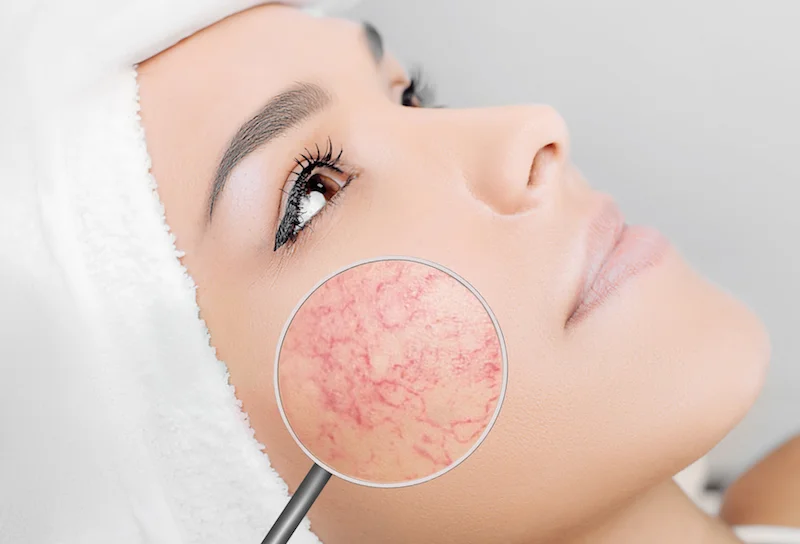Broken blood vessels on face are a common skin condition, often appearing as fine, web-like patterns or red marks. While not typically harmful, they can cause cosmetic concerns, prompting individuals to seek treatments to diminish their appearance. Understanding broken blood vessels on face is crucial for maintaining skin health and aesthetics, as it can highlight underlying health issues or the need for lifestyle adjustments.
Understanding the nature, causes, and treatments of broken blood vessels on face empowers individuals to make informed decisions about their skin health. Whether these vessels are a result of genetics, environmental factors, or lifestyle choices, recognizing the signs and knowing when to seek professional advice are the first steps towards treatment and prevention.
Table of Contents
ToggleWhat Are Broken Blood Vessels?
Broken blood vessels on face refer to small capillaries that have burst or become dilated, leading to visible red or purple marks on the skin.

These marks, often called spider veins or telangiectasia, can appear anywhere on the body but are most commonly seen on the face, particularly around the nose, cheeks, and chin.
Causes Behind Broken Blood Vessels on Face
The appearance of broken blood vessels on face can be attributed to various factors, ranging from genetic predispositions to environmental triggers and lifestyle habits:
- Genetic Factors and Heredity: A significant predisposition, with some individuals more prone due to family history.
- Environmental Triggers:
- Sun exposure: UV rays can weaken capillary walls, causing them to break.
- Extreme weather: Cold winds and heat can cause capillary damage.
- Physical and Lifestyle Causes:
- Injury: Trauma to the skin can rupture blood vessels.
- Aging: Thinning skin and loss of elasticity make capillaries more visible.
- Alcohol consumption and smoking: These can dilate blood vessels and lead to permanent changes.
- Skin Conditions:
- Rosacea: A key factor in the development of visible blood vessels.
Understanding these causes is essential for prevention and choosing the right treatment strategy. Each factor contributes differently, making it crucial to tailor prevention and treatment to individual circumstances.
Symptoms and Identification
Recognizing Broken Blood Vessels on Face
Identifying broken blood vessels on face involves noting the distinct visual characteristics they exhibit. Here are the signs to look out for:
- Fine, thread-like lines
- Web-like patterns
- Red to purple coloration
- Common areas: nose, cheeks, and neck
Understanding these visual cues is crucial for distinguishing broken blood vessels on face from other skin issues like acne or general redness.
Professional Diagnosis
Seeking a dermatologist’s opinion is advisable when:
- The appearance of broken blood vessels on face causes cosmetic concern or distress.
- The condition persists or worsens over time.
During a professional examination, one might expect:
- A visual inspection of the affected areas.
- Possible use of diagnostic tools to examine the skin closely.
- Discussion of medical history and lifestyle factors.
A dermatologist can accurately diagnose broken blood vessels on face, distinguishing them from other conditions and recommending appropriate treatment plans.
Treatment Options Explored
Professional Treatments for Broken Blood Vessels on Face
For those seeking solutions for broken blood vessels on face, professional treatments offer effective outcomes. Here are the most common methods:
- Laser Therapy:
- Description: Uses focused light to heat and damage the affected vessels, causing them to collapse and fade.
- Ideal Candidates: Individuals with visible, superficial blood vessels.
- Expected Outcomes: Reduction in visibility of vessels, with possible need for multiple sessions.
- Side Effects: Temporary redness, swelling, and, rarely, skin discoloration.
- Intense Pulsed Light (IPL) Therapy:
- Operational Principle: Emits a range of light waves that target hemoglobin, heating and destroying the vessels.
- Suitability: Effective for lighter skin tones and varied types of vascular lesions.
- Recovery: Minimal downtime, with guidance to avoid sun exposure post-treatment.
Choosing between treatments involves considering factors like skin type, severity of the condition, and personal health. Consultation with a dermatologist is essential to determine the most suitable option.
At-Home Care and Remedies
While professional treatments are often necessary for significant results, certain home remedies can provide relief and minor improvements:
- Cold Therapy: Applying a cold compress can reduce redness temporarily.
- Witch Hazel: Known for its astringent properties, aiding in skin toning and reducing redness.
- Aloe Vera: Offers soothing properties that can calm skin inflammation.
It’s important to recognize the limitations of home treatments and consider professional advice when conditions persist or worsen.
Preventive Measures
Protecting Your Skin
Preventing broken blood vessels on face involves several proactive steps focused on skin protection and lifestyle adjustments:
- Sun Protection:
- Use broad-spectrum sunscreen daily.
- Wear protective clothing and hats.
- Lifestyle Adjustments:
- Moderate alcohol consumption.
- Quit smoking to improve overall skin health.
- Incorporate a diet rich in antioxidants.
Skincare Routine Adjustments

To further prevent the occurrence of broken blood vessels on face, consider the following skincare tips:
- Use gentle cleansing products to avoid irritating the skin.
- Apply moisturizer regularly to maintain skin hydration.
- Manage underlying conditions like rosacea with appropriate treatments to reduce flare-ups.
Incorporating these preventive measures can significantly reduce the risk of developing broken blood vessels on face and maintain healthy, resilient skin.
Frequently Asked Questions
- What causes broken blood vessels on face?
- Causes include genetics, environmental factors (like sun exposure), physical impacts, lifestyle choices (such as alcohol consumption), and certain skin conditions, notably rosacea.
- Can broken blood vessels on face disappear on their own?
- In some cases, minor broken blood vessels on face may fade over time. However, more prominent vessels often require professional treatment for significant improvement.
- Are treatments for broken blood vessels on face safe?
- Yes, treatments like laser therapy and IPL are generally safe, with many individuals experiencing minimal side effects. It’s essential to consult with a dermatologist to determine the best treatment option based on your skin type and condition.
- How can I prevent broken blood vessels on face?
- Prevention strategies include protecting your skin from the sun, avoiding extreme temperatures, moderating alcohol consumption, and not smoking. Additionally, gentle skincare practices can help maintain skin health.
- Is it necessary to see a dermatologist for broken blood vessels on face?
- While not always necessary, consulting a dermatologist is advisable for anyone concerned about their skin’s appearance or seeking to explore treatment options.
Conclusion
Understanding and addressing broken blood vessels on face is essential for maintaining skin health and aesthetics. While they are often not harmful, their appearance can be a cosmetic concern for many. With the right preventive measures and treatments, it is possible to reduce their visibility and prevent new ones from forming. Consulting with a dermatologist can provide personalized advice and treatment planning, ensuring the best possible outcome for your skin.
READ ALSO:
-
Understanding Blurred Vision ICD 10 Code H53.8: Comprehensive Insight and Guidelines
-
L612 White Pill: Uses, Side Effects, Dosage, and Essential Benefits – Comprehensive Guide
-
Top 5 Health Benefits of Moringa Seeds: Your Essential Guide
-
Tinea Pedis Medication: Your Ultimate Guide to Fighting Athlete’s Foot
